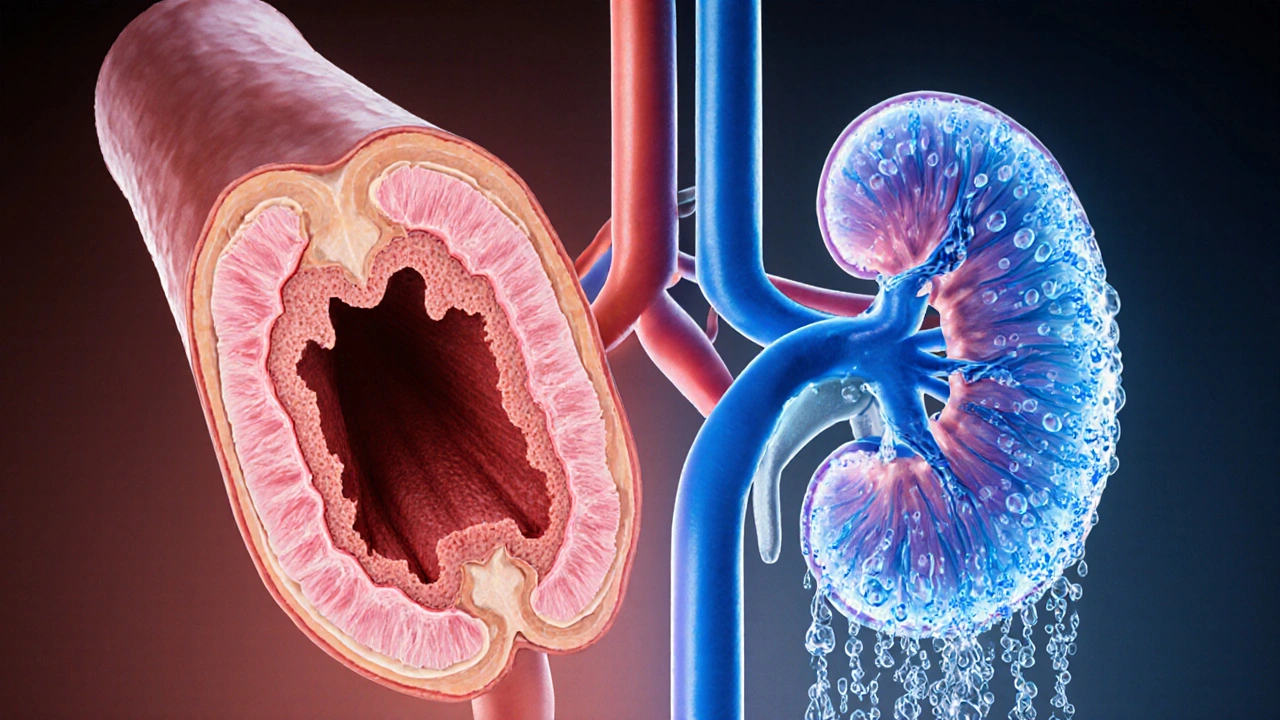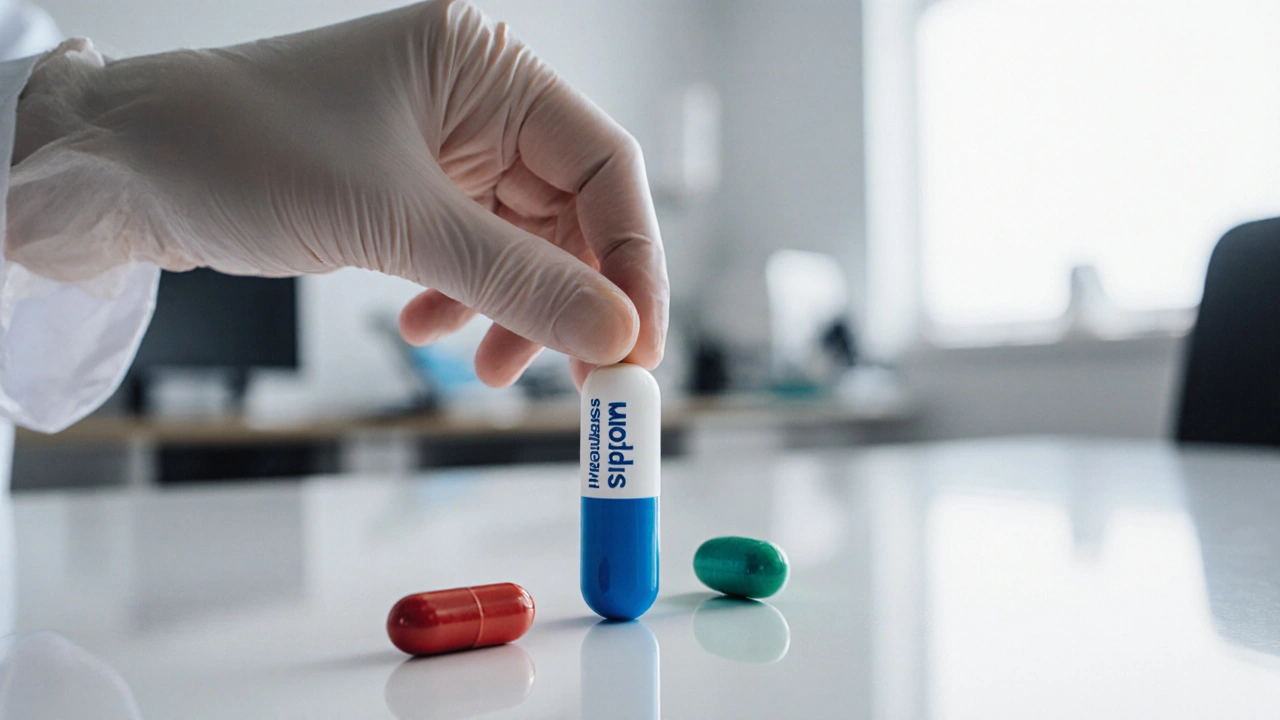Micardis Plus (Telmisartan & Hydrochlorothiazide) vs Top Hypertension Alternatives
14 Oct, 2025Hypertension Medication Cost & Safety Calculator
Personalize Your Comparison
Select your health factors to see which medication might work best for you.
Your Personalized Comparison
Micardis Plus
Best Alternative
Choosing the right blood‑pressure pill can feel like a guessing game, especially when brand names sound similar and side‑effects overlap. This guide pits Micardis Plus - a combo of telmisartan and hydrochlorothiazide against the most common single‑agent and combo alternatives, so you can see which option fits your health profile, budget, and lifestyle.
Key Takeaways
- Micardis Plus mixes an angiotensinII receptor blocker (ARB) with a thiazide diuretic, offering strong BP control in one pill.
- Alternatives such as losartan‑hydrochlorothiazide, amlodipine, lisinopril, and chlorthalidone have comparable efficacy but differ in side‑effect risk and dosing frequency.
- Kidney function, electrolyte balance, and comorbidities (e.g., diabetes) should drive the final choice.
- Cost varies considerably: generic combos are usually cheaper than branded Micardis Plus, though insurance coverage can flip the equation.
- Always discuss any switch with your prescriber; abrupt changes can spike blood pressure.
How Micardis Plus Works
Telmisartan is an angiotensinII receptor blocker (ARB) that relaxes blood vessels by blocking the hormone angiotensin II. Hydrochlorothiazide belongs to the thiazide class of diuretics; it helps the kidneys flush excess sodium and water, lowering blood volume. Together, they attack high blood pressure from two angles, often achieving target readings faster than a single agent.
Major Alternatives on the Market
Below are the most frequently prescribed alternatives, each with its own mechanism, dosing schedule, and safety profile.
- Losartan‑Hydrochlorothiazide - another ARB‑diuretic combo, marketed under names like Hyzaar.
- Amlodipine - a calcium‑channel blocker (CCB) that widens arteries.
- Lisinopril - an ACE inhibitor that reduces angiotensin‑II production.
- Chlorthalidone - a thiazide‑like diuretic often used alone or with an ARB/ACE‑I.
- Atenolol - a beta‑blocker that slows heart rate and reduces cardiac output.

Comparison Table: Micardis Plus vs Popular Alternatives
| Medication | Class | Typical Dose | BP Reduction (mmHg) | Key Side Effects | Average Monthly Cost (AU$) |
|---|---|---|---|---|---|
| Micardis Plus | ARB + Thiazide | 40mg / 12.5mg once daily | ~‑15 / ‑10 | Dizziness, electrolyte imbalance, cough (rare) | 55-70 (brand) |
| Losartan‑Hydrochlorothiazide | ARB + Thiazide | 50mg / 12.5mg once daily | ~‑13 / ‑9 | Dizziness, hyperuricemia, mild cough | 45-60 (generic) |
| Amlodipine | Calcium‑Channel Blocker | 5mg once daily | ~‑12 | Peripheral edema, flushing, headache | 30-40 (generic) |
| Lisinopril | ACE Inhibitor | 10mg once daily | ~‑14 | Cough, angioedema, elevated potassium | 25-35 (generic) |
| Chlorthalidone | Thiazide‑like Diuretic | 12.5mg once daily | ~‑10 | Hypokalemia, gout flare, photosensitivity | 20-30 (generic) |
| Atenolol | Beta‑Blocker | 50mg once daily | ~‑8 | Bradycardia, fatigue, cold extremities | 15-25 (generic) |
When Micardis Plus Might Be the Right Choice
If you need aggressive BP control and prefer a single pill, Micardis Plus shines. It’s especially helpful for:
- Patients who have already tried a solo ARB and need the extra diuretic push.
- Those with mild to moderate fluid retention (e.g., early-stage kidney disease) where a thiazide offers added benefit.
- Individuals intolerant to ACE‑inhibitor cough, since ARBs have a lower cough rate.
However, keep an eye on potassium and sodium levels; the combo can tip the electrolyte balance, especially if you’re on other potassium‑sparing drugs.
Scenarios Where an Alternative May Edge Out
Not every patient thrives on an ARB‑diuretic combo. Consider these situations:
- History of gout. Thiazides raise uric acid; a CCB like amlodipine avoids that risk.
- Pregnancy. ARBs and thiazides are contraindicated. Labetalol or methyldopa are safer, though outside this comparison.
- Severe chronic kidney disease (eGFR<30mL/min). Low‑dose ACE inhibitors or carefully monitored ARBs without diuretics may be preferred.
- Cost‑sensitive patients. Generic lisinopril or chlorthalidone often cost half of branded Micardis Plus.

Potential Pitfalls & How to Avoid Them
Switching or starting any antihypertensive can trigger short‑term spikes. Follow these tips:
- Check baseline electrolytes (Na, K, Mg) before the first dose.
- Start at the lowest effective dose; titrate every 2‑4 weeks.
- Monitor blood pressure twice daily for the first two weeks.
- Educate yourself on symptoms of low potassium (muscle cramps, irregular heartbeat).
- Ask your pharmacist about mail‑order generic options that match efficacy.
Real‑World Patient Stories (Illustrative)
Jane, 58, Brisbane - diagnosed with stage1 hypertension, she tried lisinopril alone but still hovered at 145/92mmHg. Her doctor added Micardis Plus; within a month her reading dropped to 128/80mmHg. She reports mild ankle swelling (common with thiazides) that resolved after sodium intake adjustments.
Mark, 62, Melbourne - has gout and a history of hyperuricemia. His physician avoided thiazides and chose amlodipine 5mg daily. Blood pressure settled at 130/78mmHg, and his uric acid stayed stable.
Bottom Line Decision Checklist
| Consideration | Micardis Plus | Alternative Preferred |
|---|---|---|
| Need for single‑pill regimen | Yes | Losartan‑HCTZ (also combo) |
| History of gout | Not ideal | Amlodipine or Chlorthalidone alone |
| Pregnancy | Contraindicated | Labetalol (outside scope) |
| Renal impairment (eGFR<30) | Use caution | Low‑dose ACE/ARB without diuretic |
| Cost‑sensitivity | Higher brand cost | Generic Lisinopril or Chlorthalidone |
Frequently Asked Questions
What makes Micardis Plus different from regular Micardis?
Regular Micardis contains only telmisartan (the ARB). Micardis Plus adds hydrochlorothiazide, a thiazide diuretic, giving you two mechanisms of action in one tablet, which often leads to faster and larger reductions in blood pressure.
Can I switch from Micardis Plus to a generic combo?
Yes. Losartan‑hydrochlorothiazide (e.g., Hyzaar) or a pharmacist‑compounded generic telmisartan‑HCTZ can be used. Always taper under doctor supervision to avoid sudden BP spikes.
Do I need regular blood tests while on Micardis Plus?
Yes. Check electrolytes (especially potassium) and kidney function before starting, then repeat at 4‑6weeks and annually if stable.
Is Micardis Plus safe for people with diabetes?
Generally, yes. The ARB component protects kidneys, which is beneficial for diabetics. However, the thiazide can raise blood sugar slightly, so monitor glucose closely when initiating therapy.
What are the most common side effects?
Dizziness, light‑headedness, increased urination, and occasional electrolyte disturbances (low potassium, high sodium). Rarely, patients report a dry cough, similar to ACE inhibitors, but far less frequently.
Ultimately, the “best” medication hinges on your personal health picture, other meds you’re taking, and cost considerations. Use the tables above, talk to your GP or pharmacist, and keep track of how you feel after the first few weeks. The right choice will keep your numbers down and your quality of life up.

Elle Trent
October 14, 2025 AT 21:48When you stack telmisartan with hydrochlorothiazide, you’re essentially creating a pharmacodynamic synergy that spikes the RAAS blockade while simultaneously aggravating natriuresis, which can precipitate electrolyte derangements in susceptible phenotypes. The mechanistic profile of Micardis Plus includes a potent AT1‑receptor antagonism paired with a thiazide‑induced distal convoluted tubule inhibition, driving both vasodilation and volume depletion. In patients with borderline renal reserve, this dual‑hit can tip the eGFR curve downward, prompting clinician‑led dose adjustments or even drug discontinuation. Moreover, the cost‑effectiveness calculus must factor in the pill‑burden reduction versus the potential for orthostatic hypotension, especially in geriatric cohorts. Clinicians should therefore scrutinize baseline serum potassium, monitor for hyperuricemia, and counsel on dietary sodium restriction to mitigate adverse outcomes. The therapeutic window remains narrow, demanding vigilant labs and patient education.
Jessica Gentle
October 15, 2025 AT 14:28For anyone trying to decide between Micardis Plus and other antihypertensives, a good starting point is the patient’s comorbidity profile. If chronic kidney disease is present, agents like ACE inhibitors or ARBs without a thiazide component may be gentler on renal function. Lifestyle modifications-dietary DASH, regular aerobic activity, sodium reduction-remain the backbone of therapy and often allow lower drug dosages. When cost is a concern, generic formulations of telmisartan or hydrochlorothiazide separately can be combined on a per‑prescription basis for a cheaper alternative. Don’t forget to schedule routine follow‑ups to reassess blood pressure trends and lab values; personalized adjustments keep treatment both safe and effective.
Samson Tobias
October 16, 2025 AT 07:08Hey folks, just wanted to add a quick note of encouragement: managing hypertension can feel overwhelming, but every small step counts. Tracking your readings at home and sharing them with your healthcare team builds confidence and empowers you to make informed tweaks. Celebrate each stable reading-it’s a win for your heart, kidneys, and overall well‑being. Keep the momentum going, and remember you’ve got a community here cheering you on.
Alan Larkin
October 16, 2025 AT 23:48Honestly, the data on Micardis Plus is as clear as day-if you’ve got a normal eGFR, the combo works like a charm, but once you dip below 60, you’re flirting with hypokalemia and orthostatic drops. 😅 The pharmacokinetic synergy is impressive, yet over‑reliance on a single pill can mask the need for lifestyle tweaks. Come on, let’s not forget the basics: low‑salt diet, regular exercise, and stress management. Those habits still win the long‑term battle against hypertension. And for those who prize a minimalist regimen, a single‑tablet combo does simplify adherence-just keep an eye on labs!
John Chapman
October 17, 2025 AT 16:28One must appreciate the intellectual elegance of combining an angiotensin‑II receptor blocker with a thiazide diuretic-an approach that epitomizes pharmacological precision. Yet, the pretentious allure of a “one‑pill wonder” should not eclipse the nuanced art of titrating each component to the patient’s physiological canvas. In elite clinical practice, we dissect the subtleties of sodium‑glucose cotransporter interplay, renal autoregulation, and endothelial function before deeming any regimen definitive.
Tiarna Mitchell-Heath
October 18, 2025 AT 09:08Listen up, the whole “Micardis Plus is perfect for everyone” narrative is utter nonsense. If you’ve got a borderline kidney issue, that thiazide will shove you into a dehydration crisis faster than you can say “BP spike.” Stop swallowing marketing hype and demand a thorough renal panel before you even think about that combo. Aggressive monitoring isn’t optional-it’s mandatory.
Katie Jenkins
October 19, 2025 AT 01:48First, the pharmacodynamics of telmisartan paired with hydrochlorothiazide are well documented: AT1 blockade plus volume depletion. Second, the literature consistently shows a modestly higher incidence of hypokalemia in patients over 65 on this combo. Third, adherence improves with a single‑pill regimen, yet that benefit must be weighed against the risk profile. Fourth, insurers often reimburse the fixed‑dose combination more favorably than separate agents, influencing out‑of‑pocket costs. Fifth, clinicians should schedule potassium checks within 2‑4 weeks of initiation. Sixth, lifestyle interventions remain a cornerstone-no drug can replace a low‑sodium diet. Seventh, if a patient presents with gout, the thiazide component may exacerbate uric acid levels, demanding prophylaxis.
Roger Wing
October 19, 2025 AT 18:28Look, the pharma giants want you to believe that a combo pill is the answer, but that’s just a distraction from the real agenda-big data harvesting. Every time you take Micardis Plus, they log your vitals, your labs, and your compliance, feeding a central repository that fuels AI‑driven insurance algorithms. It’s a subtle form of control, masking itself as convenience. Stay vigilant, question the one‑size‑fits‑all narrative, and demand transparency.
Alison Poteracke
October 20, 2025 AT 11:08Hey everyone, just a friendly reminder that whatever medication you choose, it’s important to keep an eye on your overall heart health. Eating more fruits and veggies, staying active, and staying hydrated can make a big difference alongside any prescription. If you’re ever unsure, talk to your doctor- they’re there to help you find the best balance.
Marianne Wilson
October 21, 2025 AT 03:48Honestly, the whole “alternatives are better” spiel is just a fad pushed by those who can’t handle the simplicity of a combo pill. If you’re so concerned about potential side‑effects, maybe you should admit you’re scared of taking any medication at all. The reality is that Micardis Plus has been vetted in countless trials, and the data speaks louder than any contrarian blog post.
Patricia Bokern
October 21, 2025 AT 20:28Okay, picture this: you pop a pill and suddenly the world is a maze of secret labs watching your blood pressure. It’s like a thriller movie where the hero discovers the drug is actually a mind‑control device. No, seriously-stay woke, question the labels, and maybe keep a notebook of every BP reading just in case.
Garrett Gonzales
October 22, 2025 AT 13:08From a pharmacotherapeutic standpoint, the fixed‑dose combination of telmisartan and hydrochlorothiazide offers both renin‑angiotensin system inhibition and diuretic‑mediated volume control, which can be advantageous for patients with resistant hypertension. Nonetheless, clinicians should individualize therapy based on comorbidities, electrolyte status, and patient preference. Consider using the combination as a bridge to monotherapy once target BP is achieved, thereby simplifying the regimen while minimizing polypharmacy.
Aman Deep
October 23, 2025 AT 05:48🌟 Imagine the body's blood vessels as a grand ballroom, and telmisartan as the courteous host who gently opens the doors, while hydrochlorothiazide acts like the diligent usher clearing the crowd of excess fluid. Together, they orchestrate a harmonious dance of pressure reduction-quite the poetic symphony! 🎶 Yet, remember that every dance needs a rhythm; keep an eye on potassium and the occasional dizziness, lest the music stop abruptly.
Chris Smith
October 23, 2025 AT 22:28Sure, Micardis Plus works-if you love juggling side‑effects like a circus performer. 🙄 No surprise it’s marketed as a miracle pill when, in reality, it’s just another way to keep the pharma machine humming. Save yourself the circus tickets and ask your doc about ACE‑inhibitor alternatives that don’t require a daily electrolyte audit.
Camille Ramsey
October 24, 2025 AT 15:08THIS IS ABSOLUTELY RIDICULOUS! THEY THINK A SINGLE PILL CAN SOLVE EVERY HTN CASE-WHAT A JOKE! IF YOU AREN'T CHECKING YOUR POTASSIUM EVERY WEEK, YOU'RE PRACTICALLY INVITING A HEART ATTACK. GET REAL.
Raghav Narayan
October 25, 2025 AT 07:48In the realm of antihypertensive therapy, the decision to employ a fixed‑dose combination such as telmisartan with hydrochlorothiazide warrants a comprehensive appraisal of both pharmacokinetic and pharmacodynamic considerations. Firstly, telmisartan, an angiotensin‑II receptor blocker, exhibits a prolonged half‑life of approximately 24 hours, affording once‑daily dosing convenience and a steady plasma concentration that ensures consistent AT1‑receptor antagonism. Secondly, hydrochlorothiazide, a thiazide‑type diuretic, possesses a comparatively shorter half‑life yet contributes to volume depletion through inhibition of the Na⁺‑Cl⁻ cotransporter in the distal convoluted tubule, thereby complementing the vasodilatory effect of the ARB. Thirdly, from a renal perspective, the concomitant use of these agents can precipitate a modest decline in glomerular filtration rate, particularly in patients with pre‑existing chronic kidney disease, necessitating vigilant monitoring of serum creatinine and potassium levels. Fourthly, the synergy between these two mechanisms often results in a greater reduction in systolic blood pressure-typically an additional 5–10 mmHg-compared with monotherapy, which can be clinically significant in individuals with resistant hypertension. Fifthly, the cost‑effectiveness of a single‑pill regimen should be weighed against the potential for increased adverse events, including electrolyte disturbances such as hypokalemia and hyperuricemia, which may arise from the diuretic component. Sixthly, patient adherence is markedly improved when pill burden is reduced, a factor that can translate into better long‑term blood pressure control and reduced cardiovascular morbidity. Seventhly, dietary considerations, such as sodium restriction and adequate potassium intake, remain indispensable adjuncts to pharmacotherapy and can mitigate some of the diuretic‑induced electrolyte shifts. Eighthly, clinicians should exercise caution when prescribing this combination to older adults, as orthostatic hypotension and falls represent heightened risks in this demographic. Ninthly, the availability of generic formulations for both telmisartan and hydrochlorothiazide allows for flexible dosing strategies, including titration of each component as clinically indicated. Finally, regular follow‑up visits-ideally within 4 to 6 weeks of initiation-provide an opportunity to reassess blood pressure targets, evaluate renal function, and adjust therapy accordingly, thereby optimizing both efficacy and safety profiles.
Tara Phillips
October 26, 2025 AT 00:28Stay consistent with your monitoring and you’ll see improvements.
Derrick Blount
October 26, 2025 AT 17:08While the extensive exposition provided by the prior comment is thorough, it nonetheless overlooks the practical nuance of patient‑specific comorbidities-particularly, the interplay of concurrent beta‑blocker therapy, which can obscure the isolated impact of the telmisartan‑hydrochlorothiazide regimen; thus, clinicians must integrate a holistic medication reconciliation process to preempt inadvertent hypotensive episodes and electrolyte dysregulation.
Priya Vadivel
October 27, 2025 AT 09:48I appreciate the deep dive on pharmacology, but for many patients the biggest barrier is simply remembering to take the pill each day; simple reminder tools or pill organizers can be as vital as any lab test.
Dharmraj Kevat
October 28, 2025 AT 02:28Micardis Plus is not a cure‑all; lifestyle still matters.